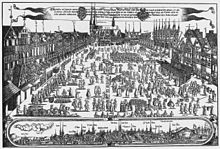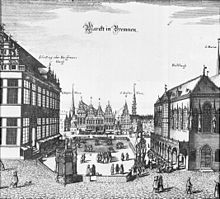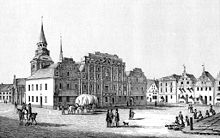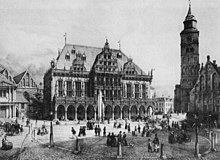Marketplaces in Germany
The title “Marketplace” is given to places within a town where goods have been or are being sold and bought. This type of trade made a major contribution to the prosperity of cities in the Middle Ages . Since the beginning of urban development , markets have been the centers of urban life, often including areas of high urban development rank. Depending on their function, they are often located in the center of historical city centers . The history of the marketplaces in Germany goes back to the 10th century.
10th to 12th centuries
Creation of local markets
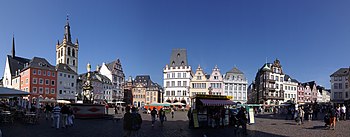
During this period, the number of places where markets regularly took place multiplied. Bishops and monasteries were given the right to hold annual markets , and later weekly markets as well . There they traded in food on the one hand - bread, flour, dairy products, meat and field crops - and on the other hand in a wide variety of handicrafts . Markets of this type were of particular importance for the surrounding area and are therefore referred to as local or local markets. They differed from the sometimes much older trading centers that arose on long-distance trading routes such as the Via Regia (Königsstrasse), the Kupferstrasse , the salt and amber routes and to which merchants traveled over great distances to buy salt, metals, silk, Barter furs and other goods, mostly on behalf of their respective feudal lords .
The general prerequisite for the development of local markets was the increasing division of labor and the simultaneous spatial separation of agriculture and handicrafts. Specifically, markets emerged where favorable preconditions existed: relatively high density of settlements in the area, good transport links, a strategically prominent location, for example at important river crossings, protection from powerful feudal lords. These promoted the development of the markets in their area by granting certain rights and privileges, assigning land and allowing timber to be felled. In return, they levied various taxes: market duty for every trade made and for the use of the market stalls and the scales . The overarching feudal lord guaranteed all market visitors, regardless of their stand, free access to the markets. The market peace applied to the precisely demarcated area and the route to it. Violations of this were subject to the king's ban - the respectively valid market regulations only had local significance, but market settlements and traders in general were under the legal protection of the king . In order to ensure the smooth operation of the market, it was even possible to suspend legal proceedings for a time.
First changes
Markets mostly developed on interurban roads, primarily where such roads intersected. Triangular or trapezoidal squares refer to their creation at a fork in the road. Often the more or less spontaneously created markets could not take up the rapidly growing movement of goods a little later. New, larger, better-planned marketplaces emerged in more suitable locations. Around the actual sales areas, the residential and utility buildings of craftsmen and merchants grew, and the density of buildings increased rapidly. Representatives of the landlords resided in fortress-like stone buildings, so-called bailiwicks , who checked dimensions and weights, regulated the allocation of stands, levied taxes and presided over the courts. There was usually a church or chapel on the market square or very close to it . With the structures thus created, the early cities received a counterweight to the previously dominant cathedral castles , palace complexes and monasteries.
The market fountain was vital for the early cities and their markets . There was no water supply in the houses, and pack animals and cattle had to be watered in the market. It was therefore essential to ensure the functionality of the well, sometimes with great effort - through deep boreholes or by channeling the water from far away. In larger cities there were fountains in other parts of the city too, but the market fountain was of particular importance. Here - or at a later time in front of the nearby town hall - was the market cross as a symbol of the market rights guaranteed by the king . The intended presence of the king should be represented by various symbols attached to it (flag, glove, sword). On the marketplaces of some north and east German cities such as Bremen or Brandenburg an der Havel there was a statue of Roland instead of the market cross - he was considered a symbol of civil liberties and the patron saint of long-distance trade merchants.
13th to 15th centuries
Growth and independence
At the end of the 14th century, the number of cities in Germany had risen to around 4,000 - the result of a wave of city foundations, with which the territorial lords wanted to make their areas more defensive and increase their income. Many of these places remained essentially villages with barely 500 inhabitants despite the city rights . Others, such as the Hanseatic cities of Lübeck and Bremen or long-distance trading centers such as Nuremberg and Augsburg , with more than 10,000 inhabitants, developed into large cities according to the standards of the time.
The well-planned layout in the center of the settlements was typical for market establishments at this time. Sometimes old trade routes were diverted to touch the new marketplaces. Regular rectangular or square floor plans resulted from the fact that one or more building blocks were left out in the middle of the new locations; such areas were mostly between 0.3 and one hectare in size. With some new foundations, especially east of the Elbe , exaggerated expectations of the later market traffic also led to places several hectares in size, which were later partially built over again. At older trading centers, the flourishing market operations made new marketplaces necessary, some of which had special functions; specialist markets for wood, pottery, trading in grazing cattle or poultry, fish, butter or grain developed. They were mostly open daily, unlike the main markets held weekly. Designations for streets and squares often remind of these markets today.
With increasing economic power, the cities gained independence in some areas from the respective feudal lords, who, in order to meet their growing need for money or to pay their debts, sold the cities various rights from jurisdiction to market rights. The newly won self-confidence of the urban bourgeoisie was expressed in the construction of town halls, which have been built on a large scale in marketplaces since the 13th century, initially as wooden structures, and in the 14th and 15th centuries as handsome stone buildings. City councils , guilds , guilds and individual wealthy families promoted the creation of representative market and city churches. They were not only used liturgically , but also as secular meeting places, for carrying out the market court and as a place of storage for the city's own treasures and documents .
The other buildings on the market also reflected the social development of the cities. Here were the estates of well-off merchants, guild masters who had become wealthy, as well as the guilds and guilds themselves, as well as inns and hostels, in individual cases also the guest houses or temporary residences of feudal lords, who did not have to pay any taxes to the city for their so-called free houses . Since living on the market was preferred, the building plots soon became smaller, and multi-storey timber and half-timbered buildings were built more frequently , with narrow gables facing the square. Since the 14th century, the city authorities tried to ensure that more and more stone was built to reduce the risk of fire. These instructions were followed with great pleasure, especially at marketplaces, because valuable goods and raw materials were often stored in the surrounding houses .
The squares formed the framework not only for the usual weekly markets. As special highlights in urban life, annual fairs were held here, to which traders and buyers came from a great distance, as well as tooth breakers and miracle doctors, fencers and wrestlers, acrobats , jugglers and musicians. Processions took place in the marketplaces, important guests were ceremonially received, and carnival and Easter games were performed. Public trials were held here and judgments were carried out in front of an audience. In the case of minor offenses, the perpetrators were whipped or chained to the pillory . For executions there was the gallows place in front of the gates of the city, but as a special deterrent they were also hung, quartered , burned or beheaded in the marketplaces . These demonstrative punishments mainly hit those delinquents whose religious or political attitudes were considered dangerous.
Stagnation and crises
The structure of the marketplaces now clearly stood out from the neighboring urban areas. Architecturally designed, closed ensembles were out of the question. Large buildings often remained construction sites for decades. In difficult times, all construction work was suspended, sometimes for generations. Wars and great fires repeatedly devastated large parts of the cities. Marketplaces were still not paved, there were domestic animals such as chickens and pigs on the sandy areas, and streams sometimes flowed through, from which water could be drawn for market operations and for firefighting. A significant episode has come down to us from the Free Imperial City of Reutlingen : Emperor Friedrich III. (1415–1493) was almost sunk in the mud of the streets during a visit to the city. After that it was no longer allowed to simply throw rubbish in front of the houses, marketplaces had to be cleaned after every market day.
In the 15th century, the cities - with the exception of the Free Imperial Cities - again lost much of their sovereignty. Social tensions increased within the communes and led to sometimes bloody confrontations, the rigidly organized guilds gradually proved to be an obstacle to general development, increasingly complex fortification work put a strain on the finances, epidemics and bad harvests aggravated critical situations. In this situation, it was easy for the sovereigns to bring many cities back into their dependence, to control the council elections and to revoke trade privileges .
16th to 18th century
Development despite a loss of power
Despite various setbacks - the economic situation of the urban merchant bourgeoisie remained satisfactory in the long term and also shaped the image of the marketplaces. The changes in power politics were barely visible. Territorial lords and citizens had the same interest in clean, comfortable markets with representative buildings. Magnificent town halls, garment and department stores, mostly in the Renaissance style , were built in feudal cities as a result of new buildings or conversions .

The redevelopment of the market changed and intensified in many places. Buildings from the 15th century were not infrequently renewed, expanded or raised in the 16th century. From the close side-by-side narrow gables, people now often switched to the structurally more favorable eaves position - the long sides of the houses faced the market, making it easier to achieve closed and straight building lines. Individual gables facing the market provided architectural accents. Elaborately designed details - portals , bay windows , windows - showed the wealth and social status of the builders. The squares themselves were leveled, at least partially paved and decorated with ornate fountains. Apart from the houses near the castle , the residential area around the market was still the most attractive area of the city. Fixed business premises were created in the colonnades of newly built houses or in the vaults of the ground floors. Residents of the market began retailing with cloths or wines here, opened a hostel or - with princely privilege - a pharmacy that offered a variety of goods in addition to medicines, including spices, confectionery, writing paper, fireworks and anti-vermin agents. Ratskeller and Ratsweinstuben gradually lost their bar monopoly , and new bars and inns established themselves on the marketplaces.
Architectural redesign and differentiated usage options increased the importance of the marketplaces, also for the social life of the cities. For a wide variety of occasions - princely weddings , inaugurations, government anniversaries - territorial lords staged large public events on the marketplaces with the intention of demonstrating their power through pomp and generosity and gaining the sympathy of the citizens. Organized entertainment included ring jousting , tournaments , carousel rides, and fireworks. When the university was founded in Halle an der Saale in 1694 , wine and beer instead of water flowed temporarily from several market fountains.
Late effects of the Thirty Years' War
The Thirty Years' War had left widespread devastation with long-lasting negative effects on urban development. As a result, the sovereigns used their scarce financial resources almost exclusively for the expansion of the residential cities , with their castles being the focus of planning and no longer the bourgeois markets. Most of the cities were neglected. As far as town hall buildings and town houses were adapted to the new style of architecture, the baroque , this was often done by means of backdrop-like false facades in an unreliable design. Urban development achievements such as the Gendarmenmarkt in Berlin and the Alte Markt in Potsdam remained exceptions.
The economic situation of the city was always evident from market traffic. The turnover, the number of dealers and buyers, the frequency and duration of the markets were subject to strong fluctuations, especially in times of war or when epidemics had reached the city. With the permission or refusal of fairs, sovereigns could intervene in the course of business and discipline the cities. The loss of urban independence continued. Princes undermined the sovereignty of the councils by issuing new city statutes and market regulations, and by increasingly influencing the filling of important offices that became paid civil servants in the 17th century.
19th and 20th centuries
Bigger cities, new town halls
The industrial revolution began with the introduction of the steam engine as the driving force in English textile companies at the end of the 18th century . During the same period, trade barriers such as guild regulations and customs barriers gradually disappeared. Road construction and inland shipping were intensified, and the expansion and networking of railway lines in the 1850s gave further strong impulses for trade and commerce. The size and structure of the cities changed fundamentally. Only two German cities, Berlin and Hamburg , had more than 100,000 inhabitants in 1830. In 1880 there were fifteen cities, in 1900 thirty-three cities. Hardly any new marketplaces were created; in many cases, the big cities came into being because smaller towns and communities, each with their own markets, grew together. “Bahnhofsstraßen”, which connected the market and the train station with each other, and where shops and service providers of a similar kind were soon to be found, as have always existed at the marketplaces, became typical . The long-established residents met the new competition with references to tradition and many years of experience (“first house on the square”).
Historic town halls on the market changed their character. Up until now, shops and stalls were common on the ground floor, but now additional administrative rooms or banks and savings banks are housed there . The large ballroom, once the venue for numerous public events, became a representative meeting room. Despite the restriction to administrative tasks, space became scarce in many places. Conversions and additions changed the appearance of the building, and individual areas, such as the police , council archives or tax authorities , had to be outsourced. Large cities like Berlin and Hamburg needed and got new large town halls around the middle of the 19th century. The founding of the Reich in 1871 triggered a real boom in town hall construction. In the newly formed German Empire , more than fifty new town halls were built in the following thirty years, mostly with towering towers and facades in the style of bygone eras. The large-volume buildings were often not compatible with the architectural standards of old markets and were built in alternative locations. In such cases, the marketplaces lost one of their centuries-old functions.
At the same time, a certain carelessness in dealing with historical building fabric, combined with commercial interests and the urge to gain recognition, meant that numerous buildings worth preserving were demolished, while others experienced drastic changes through historicizing facade designs according to the taste of the time. The losses that had already occurred and were still threatened led to more intensive efforts at the turn of the century for state-supported monument preservation , with the help of which necessary redesigns could often be carried out in such a way that the harmony of the old marketplaces was not further destroyed.
The market - annoyance and fairground
Weekly markets came under criticism because they polluted the pavement, spread unpleasant smells and were a hindrance to traffic. These reservations contributed to the fact that market halls were built in large cities or markets were relocated to less important places. In general, the marketplace lost its clear primacy as an urban trading center. However, it remained an important traffic junction for vehicles and pedestrians, an attractive location for firmly established shops. Many squares have now been illuminated for the first time and completely paved or provided with green spaces. Victory and war memorials have been widespread since the Franco-Prussian War in 1870/71 .
Above all, as the historical center of the city, the old market square remained a place of representation, of urban self-expression. It retained its special significance as a fairground in an attractive architectural setting. Officials used this backdrop for festivities of all kinds, especially in the Wilhelmine era, victory celebrations, anniversaries or official homage with garlands, flags, maid of honor and military parades were celebrated in typical national exuberance.
Political conflicts and consequences of war
However, marketplaces were also the scene of social and political, often violent, confrontations. On the Berlin Gendarmenmarkt the clashes in the run-up to the civil revolution of 1848 began as early as April 1847 with the “Berlin Potato War”: angry citizens took action against traders who had speculatively inflated their prices. In 1848 the 183 dead of the March Revolution were laid out here on the steps of the German Cathedral , in September of the same year the Prussian National Assembly met in the theater . The series of more or less violent actions in public space continued from the party struggles of the Weimar Republic to the peaceful, momentous demonstrations on numerous marketplaces in the GDR in autumn 1989.
During the Second World War , a large number of culturally, historically and architecturally unique market ensembles were completely or largely destroyed. Recovering them has been problematic for a number of reasons. At first there was a lack of technical and financial resources. Above all, however, the views about the right course of action - demolition and redesign or renovation in line with listed buildings or complete reconstruction - often diverged widely. These questions were not only discussed on a professional level and answered in different ways, but in a divided Germany also against different ideological backgrounds. Today, the inconsistent structural conditions of many marketplaces reflect these difficulties.
present

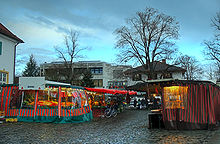
In the age of supermarkets and shopping centers , marketplaces have probably lost their function as indispensable supply facilities. Particularly in larger cities, however, special manifestations of traditional market events developed or persisted. Organic markets offer products that are declared as guaranteed natural, while products from the surrounding countryside are sold exclusively from the local area. Christmas, junk, flower and small animal markets use the old places. “Medieval markets”, a mixture of fair and open-air theater, are popular - here, costumed actors try to get as close as possible to the authentic image of the early markets as jugglers , traders or craftsmen. Architecturally attractive marketplaces are becoming attractions for locals and tourists thanks to traffic calming , decorative pavement, terrace cafes and special events such as summer concerts in the open air .
Overall, marketplaces have proven to be amazingly viable. The appearance and use changed in many respects and were adapted to the respective historical conditions, but the basic spatial structures survived. They are still of considerable importance for the social life of numerous cities.
Additional information
See also
- Agora and Forum - on the importance of central city squares in antiquity
- Market - about the term market in different meanings
- Electronic marketplace - functions of the historical market in the digital age
- Berlin-Totale: Weekly market in Pankow , film documentary (GDR, 1973)
literature
- Author collective: marketplaces. Reflections on history and culture . Henschelverlag Art and Society, Berlin 1990, ISBN 3-362-00385-0 .
- Karl Czok: The city. Your position in German history. Leipzig / Jena / Berlin 1969.
- Karl Gruber: The shape of the German city. Your change from the spiritual order of the times. Munich 1952, 1983.
- Philipp A. Rappaport: The development of the German marketplace. In: Urban planning lectures from the seminar for urban planning at the Royal Technical University of Berlin, Vol. VII, H. 3, Berlin 1914.
- Jörg and Brunhilde Valtin, “The history of the Frankfurter weekly markets”, (Association of Frankfurt Market Traders, ed.), Frankfurt am Main, 2010.



